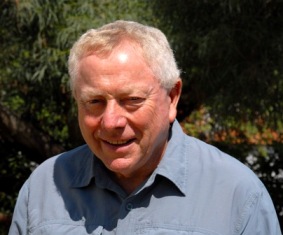Out with Papa-figos

Clive Viney - co-author of Algarve Wildlife - the natural year
Papa-figos (which literally translates as fig eater) is the Portuguese name for the Golden Oriole, one of the iconic visiting birds of the Algarve. Clive Viney is the co-author of Algarve Wildlife - the natural year, and now, under the guise of Papa-Figos, chronicles his finds, thoughts and feelings while walking in the Algarve countryside throughout the natural year. Look out for his regular updates, illustrated by his fellow co-author and photographer, Ray Tipper, who has kindly provided some of the photographs that illustrate these articles by clicking through from the links below.
The Birds of Vale do Guadiana and Castro Verde – 5th December 2019
The weather could not have been better. Perfect temperature for wide-awake birding 7° - 16° with sunshine all day, no rain and little wind. With John Edge, I collected Gonçalo Elias from Altura and we headed north towards Mértola. Our first stop at dawn was the wonderfully sited, former fiscal post at Bomberia de Guadiana. The views north and south, up and down the Rio Guadiana were superb.
We quickly added a selection of woodland and riverine birds that included Crested Tit and Hawfinch. Only Gonçalo’s ears could have picked up the rare finch but John and I did manage to see it in flight. We parked by the bridge in Mértola and quickly added more species including Blue Rock Thrush, Grey Wagtail, Blue Tit, Crag Martins and the first of several Common Kingfishers and Common Kestrels.

View towards Mertola
After coffee and delicious honey and cinnamon biscuits provided by Gonçalo we travelled westwards along the EN 267 to São João dos Caldeireiros. There we walked for a couple of kilometres or so along a track through a large party of hunters and their many dogs to a shallow-banked reservoir. Both hunters and dogs were friendly. On the reservoir were, to my astonishment, ten Mute Swans and two Black Swans among a good selection of waterfowl and waders. Both swans must have been introduced or were established escapes. An unseasonable Barn Swallow was a surprise. The first of many Red Kites and Common Buzzards were logged and we identified a Black Vulture and would later see another and Griffon Vultures.
Northwards to Penilhos we added open country species, including the first of many flocks of Calandra Larks and already that species was singing. Just beyond the cheese factory at Rolão, I was amazed to see a conspiracy of at least 20 Common Ravens – I’d only seen them in ones and twos before. With permission, we visited the reservoir and added more waterfowl. Gonçalo’s sharp ears picked up Black-bellied Sandgrouse but they could not be found on the ground.

Looking south
At Castro Verde we looked into the Schinus molle trees (pepper trees) and located no fewer than three different roosting Long-eared Owls in three different trees. All were wide-eyed and photogenic and they just peered down at us. Just beyond the town we visited the Horta da Nora Reservoir, which still had plenty of water and another exotic surprise – a pair of Egyptian Geese. With them were Eurasian Spoonbills and a Great White Egret. Along the shore were more waders including Little Ringed Plovers and Common Snipe. A Black-shouldered Kite was obliging. Then it was time for our traditional tosta mistas.

Long-eared Owl – Ray Tipper. Licence enquiry...
Replete, we travelled northwards and stopped to look at Charca das Hortas Communitáries (literally the allotments’ pond). As we disembarked a tight flock of eight Little Bustards flew over and on a close overhead wire sat my bird of the day, a Rock Sparrow. A modest best bird but it showed its identifying features well and it is a species that I’ve only rarely seen in southern Portugal.

Up close - a Long-eared Owl - picture Ray Tipper. Licence enquiry...
A vehicle-free graded track that was even suitable for my Citroën took us for several kilometres across open prairies to Fontes Bárbaras. This vast countryside was new to me and I was pleased to see that it was stocked with large grazing herds and all looked well managed. We had good views of male Hen Harriers, a wonderful bird. Flocks of at least 500 Northern Lapwings followed a plough and among them was a much lesser number of European Golden Plovers. In another direction we ‘scoped three Common Cranes, there were probably more. Gonçalo’s sharp eyes picked up a fast and low flying Merlin that John got on to but I missed. It was a fairly distant view, so I didn’t mind.

A Great Bustard takes to the air - picture Michael Chalmers
At Entradas, we finally found Great Bustards, 18 of them and a Peregrine Falcon was perched on a pylon. Greedily we looked for more Long-eared Owls at another pepper tree roost in the village but they were not there. The sun was getting low as we drove across country through São Marcos da Ataboeira and on to Corte Pequena where sandgrouse were often seen. Unfortunately, tractors with huge harrows were noisily in use and we had no luck but more Great Bustards were located.

São João dos Caldeireiros Reservoir’
I believe that our list for the day was 83 or thereabouts. I missed a couple more of the heards but that didn’t matter and an eagle that would have been another species was given away. Our misses were diving ducks (following a drought the water bodies were too shallow), White Stork (probably all snacking at a landfill somewhere), Western Jackdaw (getting scarce) and several common passerines (not enough time visiting woodland).
There was much to contemplate as we drove home after another splendid day’s birding in southern Portugal.
Papa Figos 5th December 2019
Back to Papa Figos...